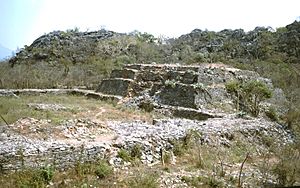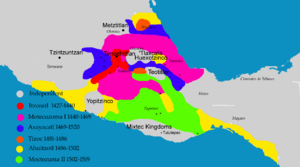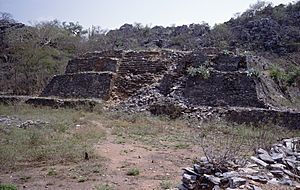Guiengola facts for kids
Quick facts for kids Zapotec Culture – Archaeological Site |
||
| Name: | Guiengola Archaeological site | |
| Type | Mesoamerican archaeology | |
| Location | Tehuantepec, Oaxaca |
|
| Region | Mesoamerica | |
| Coordinates | 16°23′09″N 95°19′24″W / 16.38583°N 95.32333°W | |
| Culture | Zapotec civilization – Zapotec peoples | |
| Language | Zapotec | |
| Chronology | 1350 to 1521 CE. (Probably earlier) | |
| Period | Mesoamerican Postclassical | |
| Apogee | ||
| INAH Web Page | zona Arqueológica de Guiengola | |
Guiengola is an ancient Zapotec city. It is an important archaeological site. You can find it about 14 kilometers (9 miles) north of Tehuantepec. It's also 243 kilometers (151 miles) southeast of Oaxaca city.
The ruins are located between a hill and a river. Both are named Guiengola. The name means "large stone" in the local Zapotec language. The site has two main tombs that have been explored. These tombs seem to be family burial places. Each tomb has a front room for religious statues. The back rooms were for burying important people.
Guiengola also has strong walls and houses. There are fields for playing ancient ballgames. You can find other tombs and a very big "palace" area. This palace once had artificial ponds and terraces. In the middle of the site are two plazas, one lower than the other. There are also two pyramids, one on the east and one on the west.
Contents
The Zapotec People and Their History
The Zapotec civilization began in the Valley of Oaxaca. This was around the late 6th Century BC. The Oaxaca Valley is a wide valley in the state of Oaxaca, Mexico. It's great for farming, especially maize (corn). This made it a good place for early settlers.
The Zapotec people called themselves Be'ena'a, meaning "The People." The name Zapotec comes from the Nahuatl language. It means "inhabitants of the place of sapote" (a type of fruit).
Early Zapotec Culture
The Zapotec civilization was a powerful group in southern Mesoamerica. Their culture dates back at least 2500 years. They built the ancient city of Monte Albán. This city had impressive buildings, ball courts, and grand tombs. They also created beautiful gold jewelry. Monte Albán was one of the first major cities in Mesoamerica. It was the center of a Zapotec state. This state controlled much of what is now Oaxaca.
The Zapotec state at Monte Albán grew bigger over time. They started taking control of areas outside the Oaxaca valley. They were able to do this because they were very strong. No other groups in the area could compete with them.
Zapotec and Mixtec artists were famous for making jewelry. They even made jewelry for the Aztec rulers in their capital, Tenochtitlan. The Zapotecs also had connections with other big cities. For example, there was a Zapotec neighborhood in Teotihuacan.
Zapotec Language and Writing
The Zapotec language is part of an old language family called Oto-Manguean. Zapotec is a tone language. This means the meaning of a word changes depending on how your voice sounds. These voice pitches are called tonemes. Zapotec languages can have different tones, like high, low, rising, or falling.
The Zapotecs also created a calendar. They developed a writing system using glyphs (symbols). Each glyph stood for a syllable of their language. This writing system might have been one of the first in Mesoamerica. It could have influenced the writing of the Maya, Mixtec, and Aztecs.
The oldest known Zapotec writing is on a stone called "Danzante" (Dancer). It was found in San Jose Mogote. This stone shows a person with two glyphs between their legs. These glyphs probably show their name.
Exploring Guiengola Site
Guiengola was built during the Post-Classic Mesoamerican period (1350-1521 CE). It was a strong Zapotec fortress. The Aztecs tried to conquer it but never succeeded. The Aztecs wanted control of trade routes to Soconusco and Guatemala.
The Zapotec ruler at that time was Cocijoeza. He and his allies, the Mixtec people, fought off the Aztec attacks. The Aztec leader was Ahuizotl (1486-1502). The fighting ended when Cocijoeza married one of Ahuizotl’s daughters. Her name was Coyolicatzin. Their son, Cocijopii, became the last Zapotec King.
When the Spanish arrived, the Zapotecs left Guiengola. But the Spanish never lived there. This means the ruins were left untouched. Guiengola's location and design suggest it was a fortified site. It likely protected the Zapotecs from enemies. It was also probably an important administrative center for the Zapotec region.
Site Investigations
The first scientific studies of Guiengola were done by Eduard Seler in 1892. Other researchers, like Aureliano Estrada, followed in 1896. More modern research happened in the 1970s by David Andrew Peterson. More work is still needed to fully understand the site.
Main Structures at Guiengola
Guiengola has a ceremonial center. It's built on a flat area measuring 150 by 200 meters (492 by 656 feet). This area was made artificially between two rocky hills. The main entrance was from the north, through a narrow valley.
The central part of the site has two sunken plazas. One plaza is higher than the other. All the buildings were made from small local stones. These stones were joined with mortar and covered with stucco.
Eastern Pyramid
The Eastern Pyramid was likely the most important building. It measures about 30 by 40 meters (98 by 131 feet). It was built on top of an older pyramid. It has a wide staircase on its west side. This staircase leads to the top. The pyramid probably served as a temple. Priests would perform ceremonies there for their gods.
In front of the pyramid is a sunken plaza with a round altar in the middle. Altars were places where offerings were left. The plazas were where people gathered for events.
West Pyramid
The Western Pyramid also has three levels. It has an 8-meter (26-foot) staircase on its west side. At the top, there are remains of an adobe building and other rooms. Like the Eastern Pyramid, it faces a sunken plaza with a round altar. These pyramids were important places for religious ceremonies.
The Palace
The Palace, or residential complex, is on the eastern side of the site. It was built on several sloped terraces. It had many rooms, some with round columns. There are courtyards with stairs connecting them.
This area likely served as the home of the ruler Cocijoeza. It had 64 rooms and other buildings. It covered an area of 11,000 square meters (118,400 square feet). The rocky land made it very well-protected. There are many stairs because of the different ground levels.
Ballgame Court
The Ballgame Court is east of the Main Plaza. It has the typical rectangular shape of a Postclassic ball court. Some researchers believe that two circular structures near the court were astronomical observatories. These rooms had openings that allowed people to watch important stars. This helped them measure time.
Outlook Point
A special viewpoint was built on a round rock. It's on the eastern side of the palace complex. From here, you can see a large part of the valley. On clear days, you can even see the Pacific Ocean. This outlook helped them watch for any movement in the river basin. It also gave a good view of the ceremonial area.
Tombs and Caves
Two tombs at Guiengola were already looted by the 1800s. One tomb is next to the wall of the Eastern Pyramid's courtyard. It has a long burial chamber with two smaller side rooms. The second tomb is under a small temple in the Palace area. This one is smaller and has three parallel rooms. It is believed the large room was a sacred place, and the side rooms were used for burials many times.
In the northern part of the valley, near the sunken Plaza, many cross-shaped tombs were found. This area is thought to be a cemetery. Many caves are also found in the hills around Guiengola. Some of these caves were used for ceremonies. They have stalactites and stalagmites. There are many exciting legends about these caves.
See also
 In Spanish: Guiengola para niños
In Spanish: Guiengola para niños
- Zapotec civilization
- Zapotec people
- Zapotec languages
- Tehuantepec
- Oaxaca
- Soconusco
Other Zapotec sites:
- Lambityeco
- Dainzu
- Mitla
- Yagul
- San José Mogote
- El Palmillo
- Zaachila








